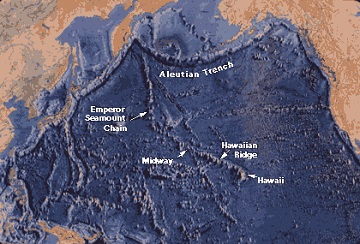To John Tuzo Wilson, Hawaii was a puzzle. Wilson was a geophysicist at the University of Toronto in the early 1960s. He was studying plate tectonics – the idea that Earth’s crust is made of a series of thin plates that float atop the mantle.
 Map of part of the Pacific basin showing the volcanic trail of the Hawaiian hotspot. Credit: USGS
Map of part of the Pacific basin showing the volcanic trail of the Hawaiian hotspot. Credit: USGSMost volcanoes are found where the plates intersect. But a few are far from the boundaries of any tectonic plates. That includes the islands of Hawaii, which are in the middle of the Pacific Plate, far from its edges.
In 1963, Wilson proposed that Hawaii and similar islands were built by “hot spots” below the crust – pools of unusually hot molten rock that percolates through cracks in the crust. The magma builds a volcano that eventually may break the surface to form an island. As the tectonic plate moves, the volcano slides away from the hot spot and shuts down. But another one builds up behind it.
Wilson’s idea explains a chain of volcanic mountains that stretches 5,000 miles from the island of Hawaii to near the tip of the Aleutian Islands near Alaska. The island of Hawaii is the youngest member of the chain, with volcanoes erupting today. To the northwest, though, the islands get older. Kauai, for example, is about five million years old.
A chain of submerged mountains extends beyond the Hawaiian islands. These are one-time islands that eroded away. The oldest is about 70 million years old.
A new volcano, Lo‘ihi, is rising to the southeast of the island of Hawaii. It may someday rise above the ocean surface – giving the Hawaiian chain a new island.

